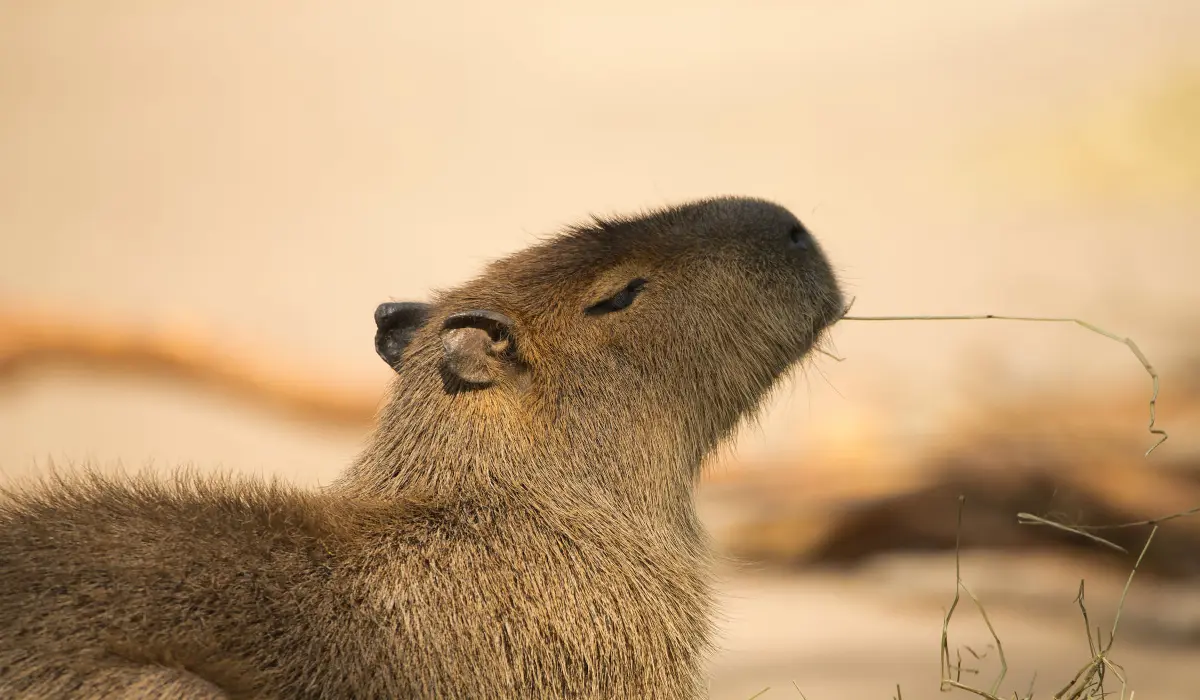Capybaras behavior showcases the complexities of their social structure, communication styles, dietary habits, and habitat preferences.
Understanding capybara behavior is not only fascinating, but it provides a window into their world, lending insight into their roles in the ecosystem and their interactions with other species.
This comprehensive guide delves deeper into the quirks and patterns of capybaras behavior, revealing what makes them such exceptional and captivating creatures.
Introduction to Capybaras
Capybaras, or Hydrochoerus hydrochaeris, are the largest living rodents in the world. Native to South America, they are found in countries like Brazil, Argentina, Colombia, and Venezuela. These large, semiaquatic animals belong to the family Caviidae, which includes other rodent species like guinea pigs and chinchillas. Adult capybaras can weigh up to 150 pounds and measure almost four feet in length.
Capybara Social Structure and Behavior
Capybaras are highly social creatures, forming stable, cohesive groups called “bands” that range from 10 to 30 individuals. Their social group’s composition usually consists of:
- One dominant male
- Several subordinate males
- A few females and their young
Dominant male capybaras take on the responsibility of protecting the band from threats and leading the group to new feeding or resting grounds. Subordinate males, on the other hand, help maintain the group’s cohesion and can eventually challenge the current dominant male for his position.
Capybara Communication: Signs and Sounds
In order to facilitate efficient communication within the band, capybaras employ a wide range of vocalizations and body language cues. They emit sounds such as teeth chattering, whistles, squeals, purrs, and grunts, along with visual cues like head raising, back arching, and tooth displaying, to express emotions or alert fellow band members.
Vocalization examples include:
- Teeth chattering: Signals annoyance or discomfort.
- Whistles and squeals: Serve as alarm calls or when on alert.
- Purring and grunting: Signify contentment or relaxation during social interactions, such as grooming or resting.
Feeding Habits and Selective Grazing
Capybaras are herbivores, mainly consuming grasses, aquatic plants, and, occasionally, fruits. They are known as “selective grazers,” meaning they selectively choose specific parts of plants to optimize their nutritional intake. Key elements of their diet include:
- High-fiber grasses: Provide the bulk of their nutrients
- Water plants: Offer additional nutrients and hydration
Capybaras have a unique digestive system with a large fermentation chamber, enabling them to break down tough plant fibers efficiently. They also practice coprophagy (eating their own feces) to further break down and absorb nutrients.
Habitat Preferences
Capybaras prefer habitats with an abundance of water, as it provides them with food, shelter, and a means to escape predators. They primarily inhabit wetland areas, such as marshes, swamps, and along riverbanks. Some typical habitat features include:
- Vegetation: Sufficient plant life for food and cover
- Water access: Proximity to ponds, lakes, rivers, or marshes to meet their hydration, hygiene, and predator evasion needs
- Mud wallows: These large rodents enjoy wallowing in mud, which helps regulate their body temperature, remove parasites, and maintain skin health.
Capybara Reproduction and Family Life
Capybaras are known to breed year-round but tend to increase their reproductive activities during the rainy season. Female capybaras carry their young for around 150 days before giving birth to a litter size of one to eight pups. Newborn capybaras are precocial, meaning they are able to walk and swim shortly after birth.
Predators, Threats, and Adaptations
Capybaras are preyed upon by a range of predators, including large birds of prey, caimans, anacondas, jaguars, and ocelots. To avoid predation, capybaras have developed several adaptations, such as:
- Living in social groups: Increases the chance of detecting a potential threat.
- Staying near water bodies: Allows for speedy escapes by diving or swimming away from danger.
- Camouflaged fur coloration: Helps them blend in with their surroundings.
Capybaras in Captivity and Human Interaction
Capybaras have become increasingly popular in zoos and wildlife parks due to their docile and sociable nature. They have also been known to form bonds with other species in captivity, such as rabbits, birds, and even reptiles. In the wild, capybaras can be quite curious and occasionally approach humans.
Capybaras and Ecosystem Health
Capybaras play a vital role in maintaining the health of ecosystems by dispersing plant seeds in their feces, promoting plant growth, and cycling nutrients through their grazing habits. However, the destruction of habitats, hunting, and illegal pet trade all pose a threat to capybara populations.
Conservation Efforts and Future Outlook
Efforts to conserve capybara populations involve habitat protection, implementation of hunting restrictions, and launching education campaigns to raise awareness about their ecological importance.
As the human understanding of capybaras deepens, we increasingly appreciate the need to protect these unique animals to ensure their survival in the wild.
In conclusion, capybaras are captivating creatures with intriguing behaviors that reflect the complex worlds of their habitat and social interactions. By exploring the many facets of their behavior and lifestyle, we can deepen our appreciation for these unique animals and contribute to their conservation and continued survival.
